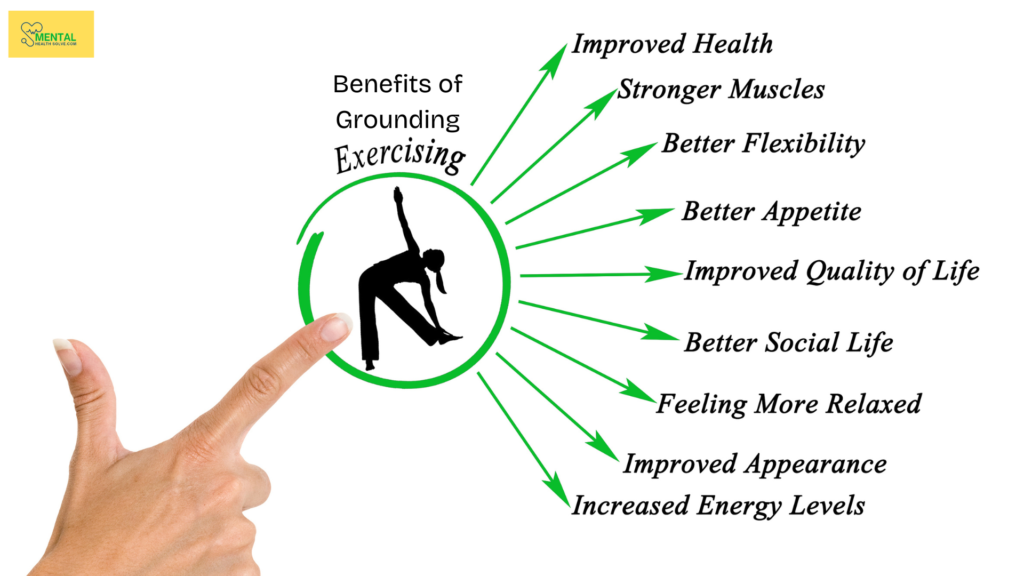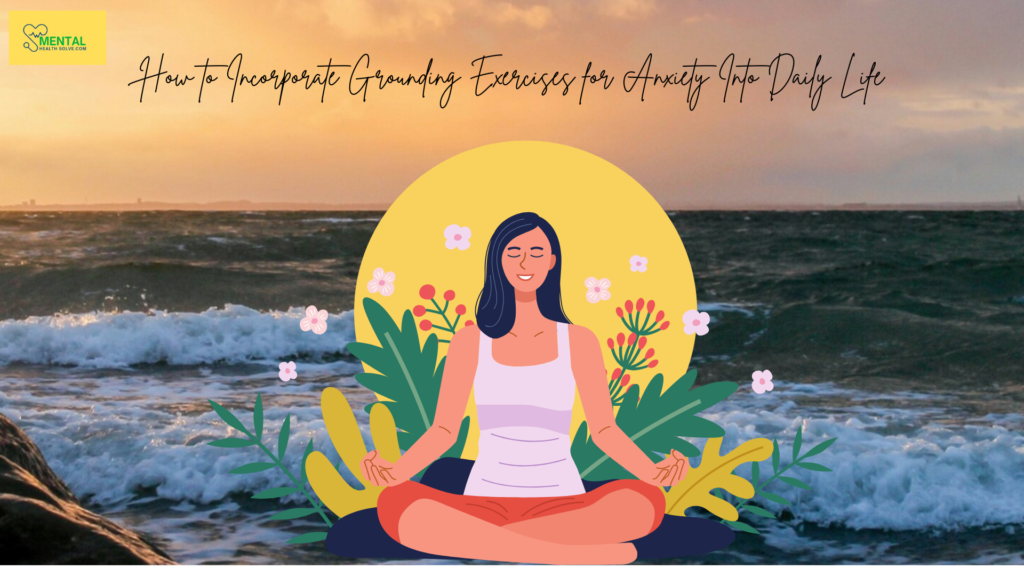Some of the best exercise and relaxation methods for anxiety are grounding exercises, which focus on bodily sensations and reduce stress levels. When people read blogs and articles, their focus tends to shift away from the emotional distress they felt earlier.
To me, grounding is one of the most potent techniques for directing anger because it makes one feel as though they have the time to heal while still in the present, aware of their breath, and distracted. Grounding Exercises for Anxiety is one of the best solutions ever.
What Are Grounding Exercises?
Grounding exercises help people feel more present by focusing on sensory experiences like their surroundings, bodies, and thoughts. Grounding Exercises for Anxiety also serve as ways to deal with anxious situations explicitly designed.
They have been designed in such a manner that enables you to divert your focus from thoughts and redirect it towards recognizing a sensation; for instance, touching an object or immersing oneself in the present moment by listening to sounds or focusing on breathing can relieve stress and promote feelings of serenity and mastery, over emotions.
Being grounded is often referred to as “mindfulness”. It involves being fully aware, without judgment towards others. Allows for a nervous system and emotional balance. Grounding Exercises for Anxiety, which can be particularly helpful for managing anxiety, will be discussed more.

Benefits of Grounding Exercises for Anxiety
Grounding Exercises for Anxiety is very essential for us. Anxiety can be managed through grounding exercises, and the first way is to keep our thoughts from wandering off and to live in the present. They are used as the first line of treatment for anxiety and emotional disorders, to reduce the severity of panic or stress, and actually to find out the power and control they improve interpersonal relationships and control problems.
In other words, the methods of grounding are the primary source of regulation of emotions or the support of calmness that requires the body and mind to be at peace. In addition, it helps with mental clutter and mindfulness, which is the ability to pay attention to things or thoughts without judging them. That is why it is generally a tool for good mental health.
Connect you to stable energy: It provides stability and control, calming fears and emotions such as panic attacks.
Exhibits will and mental health: Soothes the nervous system of the particular person and brings a sense of steadiness and another stable balancing peace.
Avoids foggy approaches and meditation: It focuses on the present moment and helps reduce the foggy brain and overthinking. Grounding techniques in dealing with stress have some outcomes related to one of their uses, which is Reducing cortisol, the “stress hormone,” so that you feel relaxed.
Learning to focus and ignore the haters – The now is the brain at its prime and clarity so we can decide better and memorize better.
Aids in battling fear and despair – Because grounding is a form of being reminded, it inhibits tension and anxiety.
Better quality sleep – As you release racing thoughts and anxiety, you ease into sleep and relaxation.
Grounding Exercises for Anxiety drive one’s sense of self, helping one overcome the past and stay focused. Following grounding techniques can help overcome psychological issues and promote mental health. They require no equipment, no special preparation, and are easy to perform, and everyone can do them.

Top Grounding Exercises for Anxiety
There are some top grounding exercises for anxiety that you should follow regularly. Such as:
Physical Grounding Exercises for Anxiety
5-4-3-2-1 Sensory Exercise: 5-4-3-2-1 Sensory Exercise is one of the best Grounding Exercises for Anxiety. This practice forces you to pull close to your senses, allowing you to enjoy the present moment and distract your attention from the worries.
Recognize:
- 5 things you can see
- 4 things you can touch
- 3 things you can hear
- 2 things you can smell
- 1 thing you can taste
Holding Onto a Textured Object: Holding Onto a Textured Object is also a good Grounding Exercises for Anxiety. The knobby armchair, the warm bathroom wall, and the rough car steering wheel are a great way to forget being nervousness.
Walking Barefoot on Grass or Sand – Walking Barefoot on Grass or Sand is one of the most fastest and effective Grounding Exercises for Anxiety. It Connects with the earth through the feet (earthing) is one of the most powerful reminders of clamness.
Besides, it has become the easiest method to lower pressure and increase relaxation. The Urban Opry’s interleaved transformation into clouds, birds, and so on builds first things to realize being happier which means your neurons begin the relaxation (prayer) of the issue in your head; the asking of questions while referring to the facts.
Mental Grounding Exercises for Anxiety
Counting Backwards from 100 – Worrying can be disrupted through mindfulness, contributing to mental alertness and purposeful engagement. First, you can recall mindful exercises like counting less or more. Another activity, like counting back slowly, can also improve your brain’s participation and cognitive circulation.
Leaning on a Mantra and Affirmation—Silent the inner critic and be kind to yourself by personalizing your affirmations. Come up with new phrases and recite them in your mind until you feel and think you are doing alright. What it means is being grounded (pun not intended) in the present moment instead of chasing World Peace or Universal Love, which is a mirage because they do not yet exist.
Naming the Items in the Room by Color or Shape – Describing or narrating the color, size, and shape of every object in the room can help recognize the personalized environment around you or the space where you are in and reinstate your presence right now (e.g., naming all yellow things and all non-circular shapes in a room) or round items).
For more Grounding Exercises for anxiety, you must visit : https://www.healthline.com/health/grounding-techniques

Breathing and Meditation Grounding Exercises for Anxiety
Deep Belly Breathing—Expanding your lung capacity through deep nose breathing effortlessly allows your body to digest tension from muscles as you repeatedly send the relaxation response signal to the higher parts of the brain.
Box Breathing Method – This exercise guides you through a breathing pattern that includes 4 seconds of inhaling, 4 seconds of holding, 4 seconds of exhaling, then holding for 4 seconds. In particular, this method helps you to calm your breath, which calms the nervous system by shifting your focus to the outside environment.
Mindful Meditation – Mental silence is achieved by creating a void in the mind by detaching functions from it and focusing on the present without reactions. Sometimes, a trip around space can occur if this meditation is done before sleep. Nonetheless, this kind of mindfulness meditation results in much lower levels of suffering and great emotional stability for well-being, relaxation and peacefulness.
How to Incorporate Grounding Exercises for Anxiety Into Daily Life
Incorporate grounding techniques in your daily life by doing grounding exercises regularly. During moments of anxiety, it is also a great time to incorporate. Lastly, create a calming routine with grounding techniques. Such as:
Practice Grounding Exercises Regularly – Adding grounding to your daily life will be a daily habit if you exercise some minutes daily to practice sensory, mental, or breathing exercises. Regularly, you get better at remaining in the current moment and handling your mind’s stress extremely well.
Use Grounding during Moments of Anxiety – In case of feeling overly frightened and stressed, try to use instantaneously a grounding technique, for example, deep breathing, holding onto a textured object, or applying the 5-4-3-2-1 method, to draw yourself into the moment that is now.
Create a Calming Routine with Grounding Techniques – Imbue grounding into your day with your morning, evening, or personal care routines. Blend it with actions such as meditation, yoga, or reading inspiring books to enhance relaxation and emotional stability.

Additional Tips apart from Grounding Exercises for Anxiety
There are some additional tips to get over anxiety and its after-effects.
- Preserve a Healthy Routine in your lifestyle
- To keep the mood in check
- It is essential to eat a balanced diet,
- Get enough sleep and rest
- Exercise regularly or follow a fitness routine.
- Journaling and Self-Reflection Practice.
- Putting things in writing and expressing your emotions can create an awareness of the advantages of dealing with your feelings and give you the necessary catharsis.
- You can also contemplate patterns, and because of that, knowledge becomes the power to develop better strategies.
- If Necessary, Get Professional Help – If you start to become too anxious, talk with a therapist, counsellor, or mental health professional to seek help. Experts in the field, namely, a proven therapist, proper medication,
- Treatment options like cognitive-behavioral therapy can also significantly help the healing process.
These tips can also be practical apart from the Grounding Exercises for Anxiety and other Mental Health issues.
Final Thoughts
Grounding exercises effectively cope with anxiety because they help us focus on the present moment, take away the stress, and find inner stability. Integrating physical, mental, and breathing techniques that help people in their daily lives will make them more resistant to anxious thoughts and bring tranquillity and control. Grounding is a skill that is developed through regular practice and mindfulness, which we all should have to protect ourselves from getting stressed during a stressful situation. Try some of the exercises and figure out what suits you the best, then let us know about the results and how you are exploring other ways of staying balanced or peaceful for an extended time.
For some other exercises, you can visit : https://mentalhealthsolve.com/top-8-types-of-workouts/
